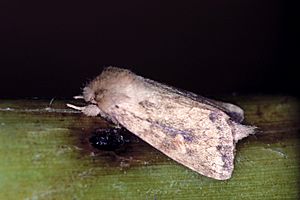Bellura densa facts for kids
Quick facts for kids Bellura densa |
|
|---|---|
 |
|
| Scientific classification | |
| Kingdom: | |
| Phylum: | |
| Subphylum: | |
| Class: | |
| Order: | |
| Family: | |
| Genus: |
Bellura
|
| Species: |
B. densa
|
| Binomial name | |
| Bellura densa (Walker, 1865)
|
|
| Synonyms | |
|
|
The pickerelweed borer moth (Bellura densa) is a type of moth from the Noctuidae family. It's known for its unique way of living inside wetland plants. This moth is found in parts of North America.
Contents
About the Pickerelweed Borer Moth
This interesting moth gets its name because its young, called larvae, often live inside plants like pickerelweed. It's a small creature but plays a part in its wetland home.
Where the Moth Lives
This moth lives in the eastern and central parts of the United States. You can find it from Maryland down to southern Florida. It also lives west into states like Indiana and Louisiana. These areas have the wetland plants the moth needs to survive.
What the Moth Looks Like
Adult pickerelweed borer moths have a wingspan of about 35 to 50 millimeters. That's roughly the length of a few paper clips. Their front wings are usually brown or tan. They have a special kidney-shaped spot, called a reniform spot, which is partly filled with orange. This helps them blend in with their surroundings.
Life Cycle and Food
Adult moths are usually seen flying from June to August. In warmer, southern areas, they can have two generations of moths in one summer. This means they complete their life cycle twice in a year.
The young moths, called larvae or caterpillars, eat different wetland plants. These include plants like Typha (cattails), Pontederia (pickerelweed), and Eichhornia (water hyacinth). When they are very young, the larvae feed on the surface of these plants. As they grow bigger, they burrow into the leaves or the underground stems, called rhizomes, of the plants. This is how they get their "borer" name.

